Spatial Heterogeneity and Influence Factors of Traditional Villages in the Wuling Mountain Area, Hunan Province, China Based on Multiscale Geographically Weighted Regression
Abstract
:1. Introduction
2. Materials and Methods
2.1. Study Areas
2.2. Methods
2.2.1. Nearest Neighbor Index
2.2.2. Standard Deviation Ellipse
2.2.3. Kernel Density Analysis
2.2.4. MGWR
2.3. Data Sources
3. Results
3.1. Spatial Heterogeneity
3.1.1. Clustering Features of Spatial Distribution
3.1.2. Directional Features of Spatial Distribution
3.1.3. Structural Features of Spatial Distribution
3.2. Influencing Factors
3.2.1. Model Comparison Analysis
3.2.2. MGWR Model Result Analysis
4. Discussion and Conclusions
4.1. Discussion
4.1.1. Influencing Factors of the Spatial Distribution of Traditional Villages
4.1.2. Strategies for the Protection and Development of Traditional Villages
4.1.3. Research Limitations and Future Works
4.2. Conclusions
Author Contributions
Funding
Data Availability Statement
Acknowledgments
Conflicts of Interest
References
- Hu, B.; Deng, X. The Origin and Early development of Chinese villages. Seeker 2019, 1, 151–160. [Google Scholar]
- Jiang, D.; Peng, C. The Phenomenon of Rural Declining in the Process of Urbanization: Causes and Governance—An Analysis from the Perspective of the Implementation of “Rural Revitalization Strategy”. J. Nanjing Audit Univ. 2018, 15, 16–24. [Google Scholar]
- Hu, Y.; Chen, S.; Cao, W. The Concept and Cultural Connotation of Traditional Villages. Urban Dev. Stud. 2014, 21, 10–13. [Google Scholar]
- The Ministry of Housing and Urban–Rural Development, the Ministry of Culture, and the Ministry of Finance Jointly Announced the First Batch of Traditional Chinese Villages. Available online: http://www.chuantongcunluo.com/index.php/Home/gjml/gjml/wid/587.html (accessed on 12 January 2023).
- The CPC Central Committee and the State Council Issued the Strategic Plan for Rural Revitalization (2018–2022). Available online: http://www.gov.cn/xinwen/2018-09/26/content_5325534.htm (accessed on 12 January 2023).
- Rao, X.; Zhou, J.; Ding, K.; Wang, J.; Fu, J.; Zhu, Q. Research on the Cultural Tracing of the Patriarchal Clan System of Traditional Buildings in the Eastern Zhejiang Province, China, Based on Space Syntax: The Case Study of Huzhai in Shaoxing. Sustainability 2022, 14, 7247. [Google Scholar] [CrossRef]
- Karol, K. The Scarecrow as Part of Polish Rural Cultural Landscapes. Agriculture 2020, 10, 496. [Google Scholar] [CrossRef]
- Peng, Y.; Ma, Z.; Zhu, D.; Liu, Z.; Meng, Q. Protection and Ecology Planning Strategy of Traditional Village Heritage, Take the Chen Lou Village as an Example. EKOLOJI 2019, 28, 921–928. [Google Scholar]
- Kouřilová, J.; Pělucha, M.; Kouřilová, J.; Pělucha, M. Economic and Social Impacts of Promoting Cultural Heritage Protection by the Czech Rural Development Programme 2007–2013. Eur. Countrys. 2017, 3, 468–503. [Google Scholar] [CrossRef] [Green Version]
- Dobrovodská, M.; Kanka, D.; David, S.; Kollár, J.; Špulerová, J.; Štefunková, D.; Mojses, M.; Petrovič, F.; Krištín, A.; Stašiov, S.; et al. Assessment of the biocultural value of traditional agricultural landscape on a plot-by-plot level: Case studies from Slovakia. Biodivers. Conserv. 2019, 28, 2615–2645. [Google Scholar] [CrossRef]
- St’astna, M.; Vaishar, A. Values of rural landscape: The case study Chlum u Trebone (Bohemia). Land Use Policy 2020, 97, 104699. [Google Scholar] [CrossRef]
- Gorka, A. Threats to Rural Landscape and Its Protection in Poland. Environments 2018, 5, 109. [Google Scholar] [CrossRef] [Green Version]
- Gorączko1, M.; Aleksandra, C. Vernacular architecture and traditional rural landscape in new socio-economic realities—A case study from Central Poland. Bull. Geography. Socio-Econ. Ser. 2015, 30, 43–58. [Google Scholar] [CrossRef] [Green Version]
- Wang, W.; Watanabe, M.; Ono, K.; Zhou, D. Exploring Visualisation Methodology of Landscape Design on Rural Tourism in China. Buildings 2022, 12, 64. [Google Scholar] [CrossRef]
- Šťastná, M.; Vaishar, A.; Ryglová, K.; Rašovská, I.; Zámečník, S. Cultural Tourism as a Possible Driver of Rural Development in Czechia. Wine Tourism in Moravia as a Case Study. Eur. Countrys. 2020, 12, 292–311. [Google Scholar]
- Gao, J.; Wu, B. Revitalizing traditional villages through rural tourism: A case study of Yuanjia Village, Shaanxi Province, China. Tour. Manag. 2017, 4, 223–233. [Google Scholar] [CrossRef]
- Meng, Q.; Wang, C.; Xu, T.; Pi, H.; Wei, Y. Evaluation of the Sustainable Development of Traditional Ethnic Village Tourist Destinations: A Case Study of Jiaju Tibetan Village in Danba County, China. Land 2022, 11, 1008. [Google Scholar] [CrossRef]
- Fazio, S.; Modica, G. Historic Rural Landscapes: Sustainable Planning Strategies and Action Criteria. The Italian Experience in the Global and Eu-ropean Context. Sustainability 2018, 10, 3834. [Google Scholar]
- Liu, S.; Ge, J.; Bai, M.; Yao, M.; He, L.; Chen, M. Toward classification-based sustainable revitalization: Assessing the vitality of traditional villages. Land Use Policy 2022, 116, 106060. [Google Scholar] [CrossRef]
- Xiao, Y.; Zhao, J.; Sun, S.; Guo, L.; Axmacher, J.; Sang, W. Sustainability Dynamics of T raditional Villages: A Case Study in Qiannan Prefecture, Guizhou, China. Sustainability 2020, 12, 314. [Google Scholar] [CrossRef] [Green Version]
- Nie, Z.; Li, N.; Pan, W.; Yang, Y.; Chen, W.; Hong, C. Quantitative research on the form of traditional villages based on the space gene—A case study of Shibadong village in western Hunan, China. Sustainability 2022, 14, 8965. [Google Scholar] [CrossRef]
- Figlus, T. Process of Incorporation and Morphological Transformations of Rural Settlement Patterns in the Context of Urban Development. The Case Study of Łódź. Quaest. Geogr. 2020, 39, 75–95. [Google Scholar]
- Bian, J.; Chen, W.; Zeng, J. Spatial Distribution Characteristics and Inflfluencing Factors of Traditional Villages in China. Int. J. Environ. Res. Public Health 2022, 19, 4627. [Google Scholar] [CrossRef]
- Wu, Y.; Wu, M.; Wang, Z.; Zhang, B.; Li, C.; Zhang, B. Distribution of Chinese traditional villages and influencing factors for regionalization. Ciência Rural. 2021, 51, e20200368. [Google Scholar] [CrossRef]
- Jin, J.; Yan, H. Analyzing the Causes of Spatial Differentiation of the Traditional Villages in Gansu Province, Western China. J. Geosci. Environ. Prot. 2020, 8, 12–25. [Google Scholar] [CrossRef]
- Yang, Y.; Hu, J.; Liu, D. Spatial difterentiation of ethnic traditional villages in Guizhou province and thenfluencing factors. J. Arid Land Resour. Environ. 2022, 36, 175–178. [Google Scholar]
- Liu, S.; Bai, M.; Yao, M.; Huang, K. Identifying the natural and anthropogenic factors influencing the spatial disparity of population hollowing in traditional villages within a prefecture-level city. PLoS ONE 2021, 16, e0249448. [Google Scholar] [CrossRef]
- Xu, Y.; Yang, X.; Feng, X.; Yan, P.; Shen, Y.; Li, X. Spatial distribution and site selection adaptation mechanism of traditional villages along the Yellow River in Shanxi and Shaanxi. River Res. Appl. 2022, 4, 3977. [Google Scholar] [CrossRef]
- Xie, G.; Zhou, Y.; Liu, C. Spatial Distribution Characteristics and Inflfluencing Factors of Hakka Traditional Villages in Fujian, Guangdong, and Jiangxi, China. Sustainability 2022, 14, 12068. [Google Scholar] [CrossRef]
- Gao, C.; Wu, Y.; Bian, C.; Gao, X. Spatial characteristics and influencing factors of Chinese traditional villages in eight provinces the Yellow River flows through. River Res. Appl. 2021, 10, 3880. [Google Scholar] [CrossRef]
- Rosner, A.; Wesołowska, M. Deagrarianisation of the Economic Structure and the Evolution of Rural Settlement Patterns in Poland. Land 2020, 9, 523. [Google Scholar] [CrossRef]
- Fanta, V.; Beneš, J.; Zouhar, J.; Rakava, V.; Šitnerová, I. Ecological and historical factors behind the spatial structure of the historical field patterns in the Czech Republic. Sci. Rep. 2022, 12, 8645. [Google Scholar] [CrossRef]
- Sklenicka, P.; Šímová, P.; Hrdinová, K.; Salek, M. Changing rural landscapes along the border of Austria and the Czech Republic between 1952 and 2009: Roles of political, socioeconomic and environmental factors. Appl. Geogr. 2014, 47, 89–98. [Google Scholar] [CrossRef]
- Jończy, R.; Śleszyński, P.; Dolińska, A.; Ptak, M.; Rokitowska, J.; Rokita, D. Environmental and Economic Factors of Migration from Urban to Rural Areas: Evidence from Poland. Energies 2021, 14, 8467. [Google Scholar] [CrossRef]
- Hanna, B. The Determinants of The Existing Conditions on The Functional and Spatial Development of Rural Areas. Civ. Environ. Eng. Rep. 2022, 32, 255–268. [Google Scholar]
- Mazurek, K. Spatial Analyses in the Research of Land Cover Changes (A Case Study). Contemp. Trends Geosci. 2015, 4, 1–13. [Google Scholar] [CrossRef]
- Wang, Q.; Bing, H.; Wang, S.; Xu, Q. Study on the Spatial Distribution Characteristics and Inflfluencing Factors of Famous Historical and Cultural Towns or Villages in Hubei Province, China. Sustainability 2022, 14, 13735. [Google Scholar] [CrossRef]
- Liao, C.; Zuo, Y.; Law, R.; Wang, Y.; Zhang, M. Spatial Differentiation, Inflfluencing Factors, and Development Paths of Rural Tourism Resources in Guangdong Province. Land 2022, 11, 2046. [Google Scholar] [CrossRef]
- Tang, H.; Li, D. Spatial Distribution Characteristics of Fringe Villages of Archipelagic City: A Case Study of Zhoushan. J. Coast. Res. 2020, 103, 469–473. [Google Scholar] [CrossRef]
- Li, C.; Wu, K. Driving forces of the villages hollowing based on geographically weighted regression model: A case study of Longde County, the Ningxia Hui Autonomous Region, China. Nat. Hazards 2017, 89, 1059–1079. [Google Scholar] [CrossRef]
- Wang, J.; Li, X.; Christakos, G.; Liao, Y.; Zhang, T.; Gu, X. Geographical Detectors-Based Health Risk Assessment and its Application in the Neural Tube Defects Study of the Heshun Region, China. Int. J. Geogr. Inf. Sci. 2010, 24, 107–127. [Google Scholar] [CrossRef]
- Fotheringham, A.; Yang, W.; Kang, W. Multiscale Geographically Weighted Regression (MGWR). Am. Assoc. Geol. Yearb. 2017, 107, 1247–1265. [Google Scholar] [CrossRef]
- Zhu, H.; Ou, X.; Yang, Z.; Yang, Y.; Ren, H.; Tang, L. Spatiotemporal Dynamics and Driving Forces of Land Urbanization in the Yangtze River Delta Urban Agglomeration. Land 2022, 11, 1365. [Google Scholar] [CrossRef]
- Liao, X.; Deng, M.; Huang, H. Analyzing Multiscale Spatial Relationships between the House Price and Visual Environment Factors. Appl. Sci. 2022, 12, 213. [Google Scholar] [CrossRef]
- Wei, F.; Li, S.; Liang, Z.; Huang, A.; Wang, Z.; Shen, J.; Sun, F.; Wang, Y.; Wang, H.; Li, S. Analysis of Spatial Heterogeneity and the Scale of the Impact of Changes in PM2.5 Concentrations in Major Chinese Cities between 2005 and 2015. Energies 2021, 14, 3232. [Google Scholar] [CrossRef]
- The CPC Central Committee and the State Council issued the Outline of China’s Rural Poverty Alleviation and Development (2011–2020). Available online: http://www.gov.cn/gongbao/content/2011/content_2020905.htm (accessed on 12 January 2023).
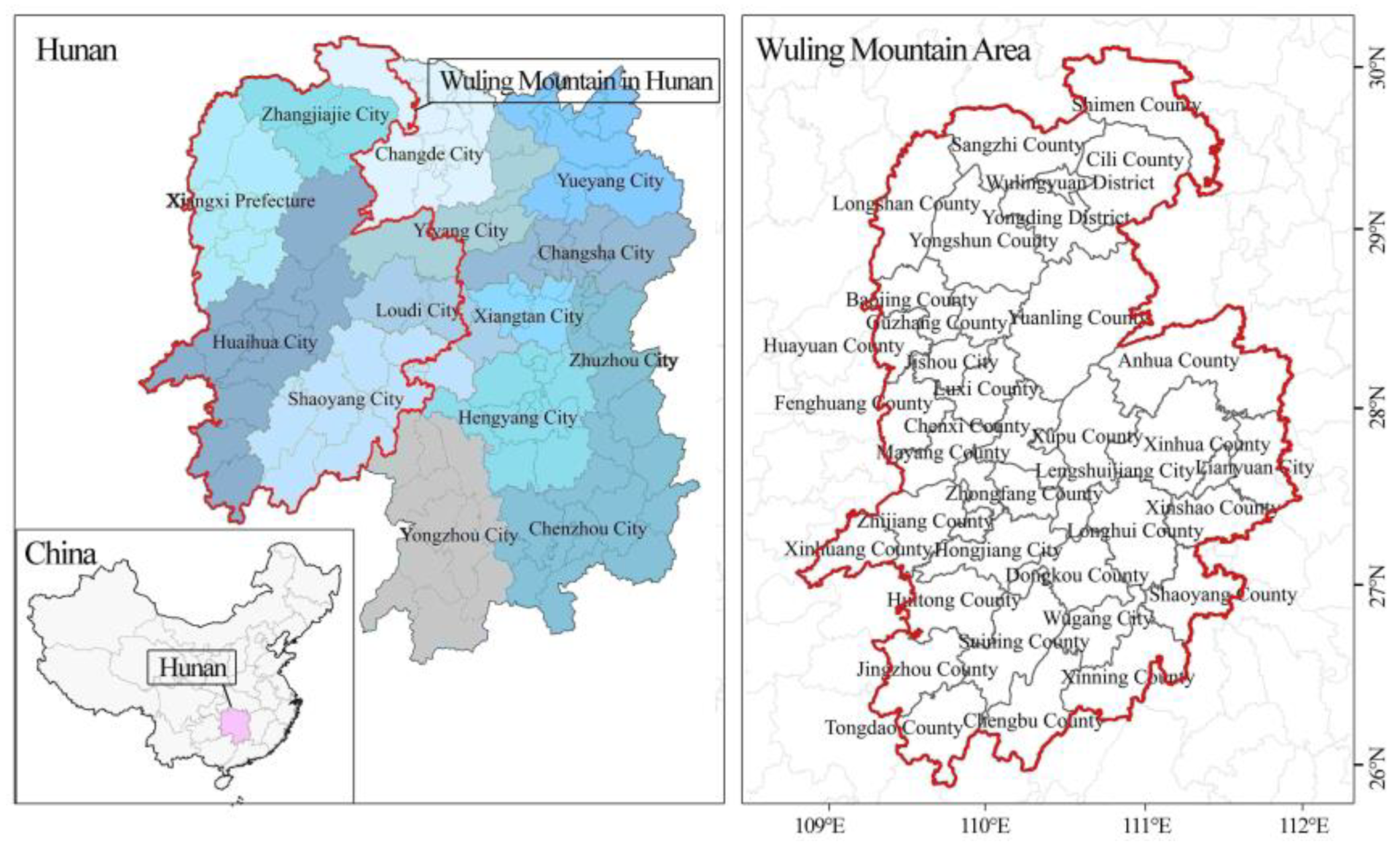
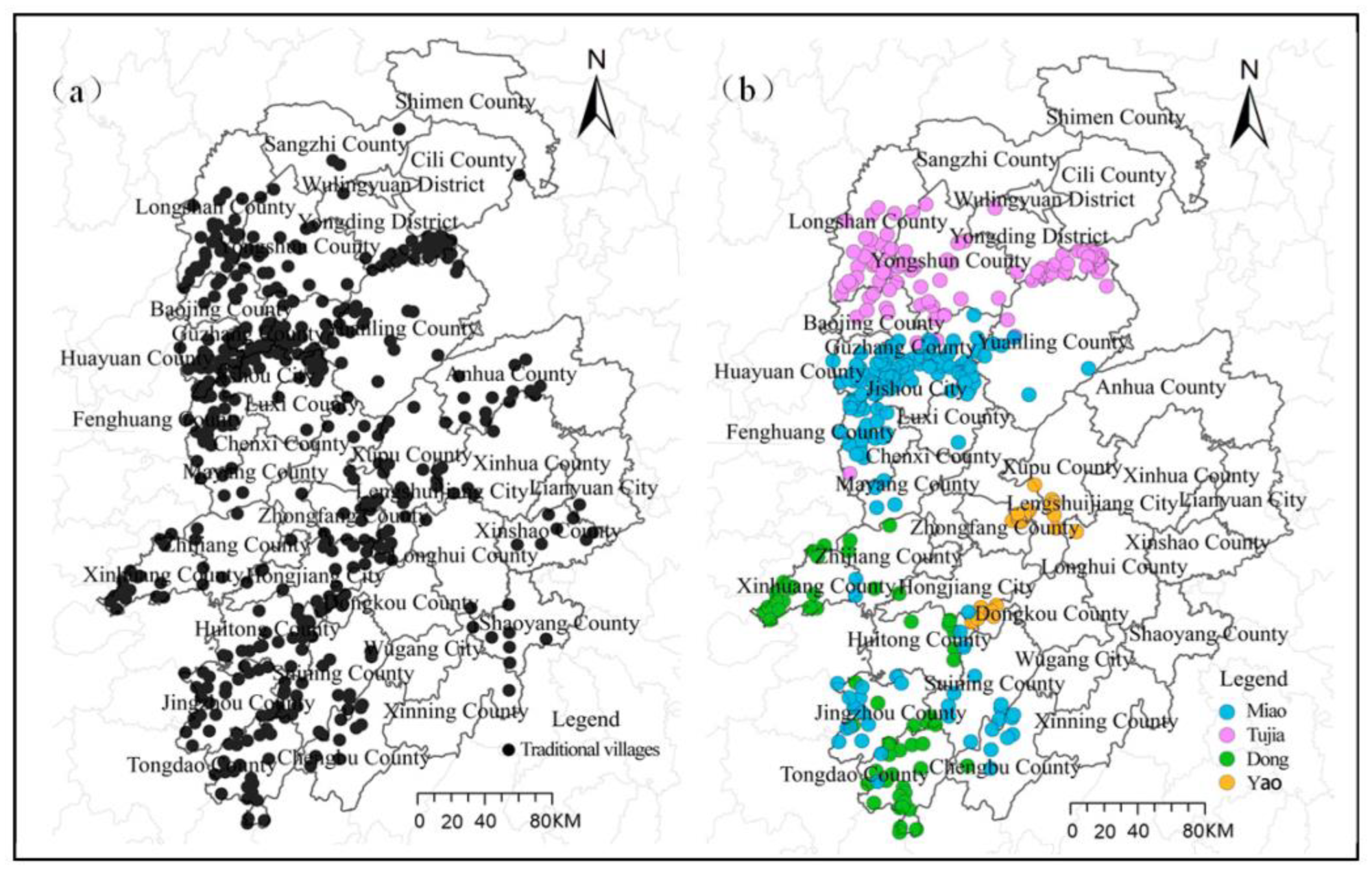

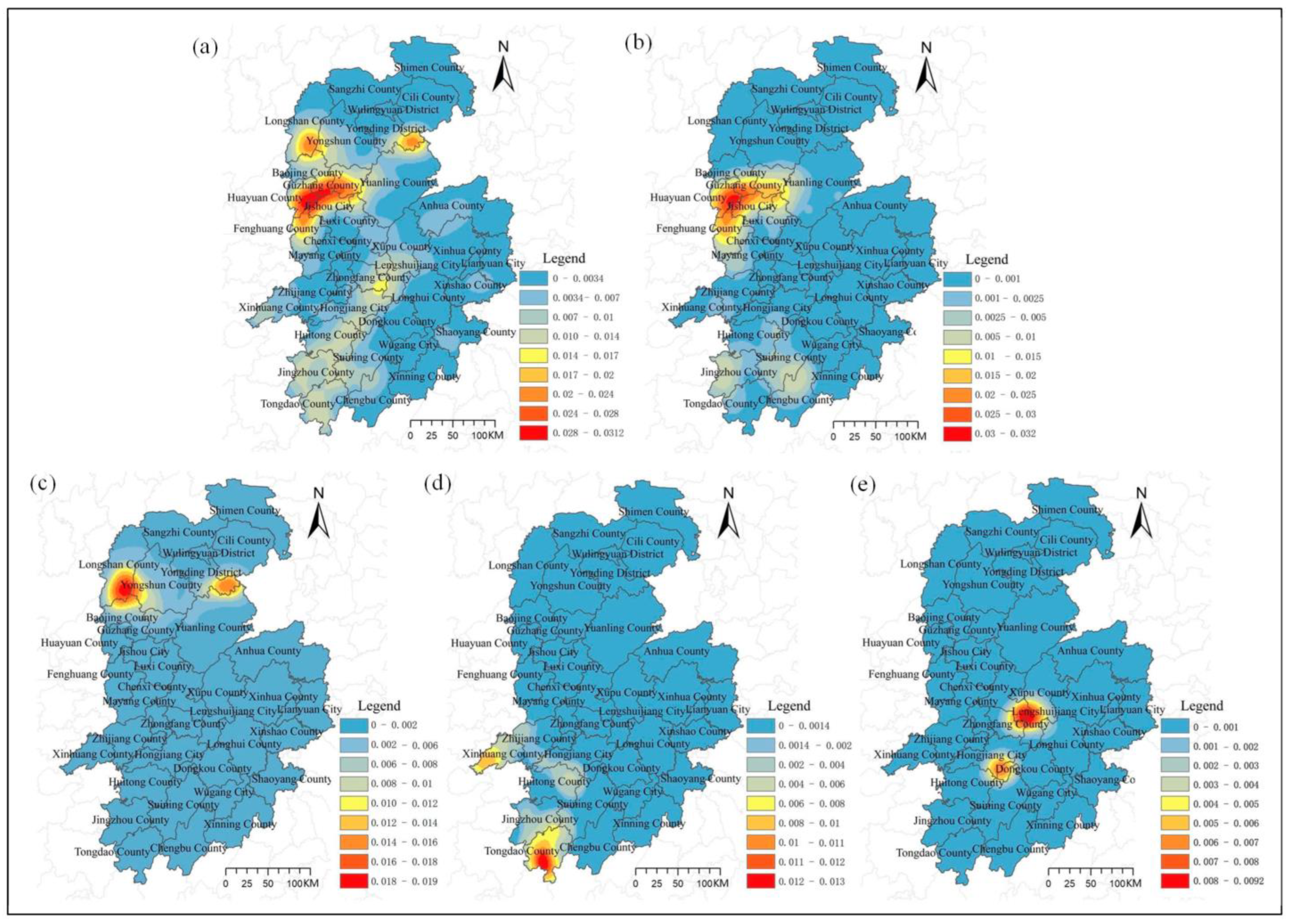
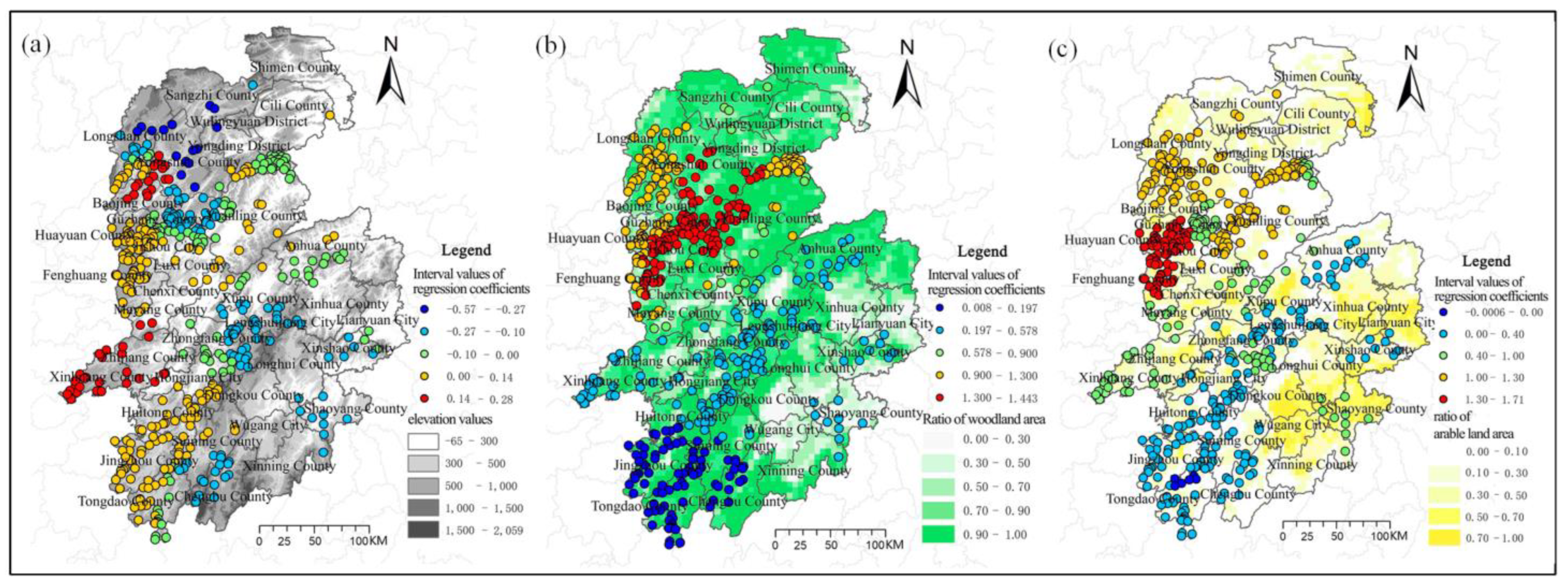
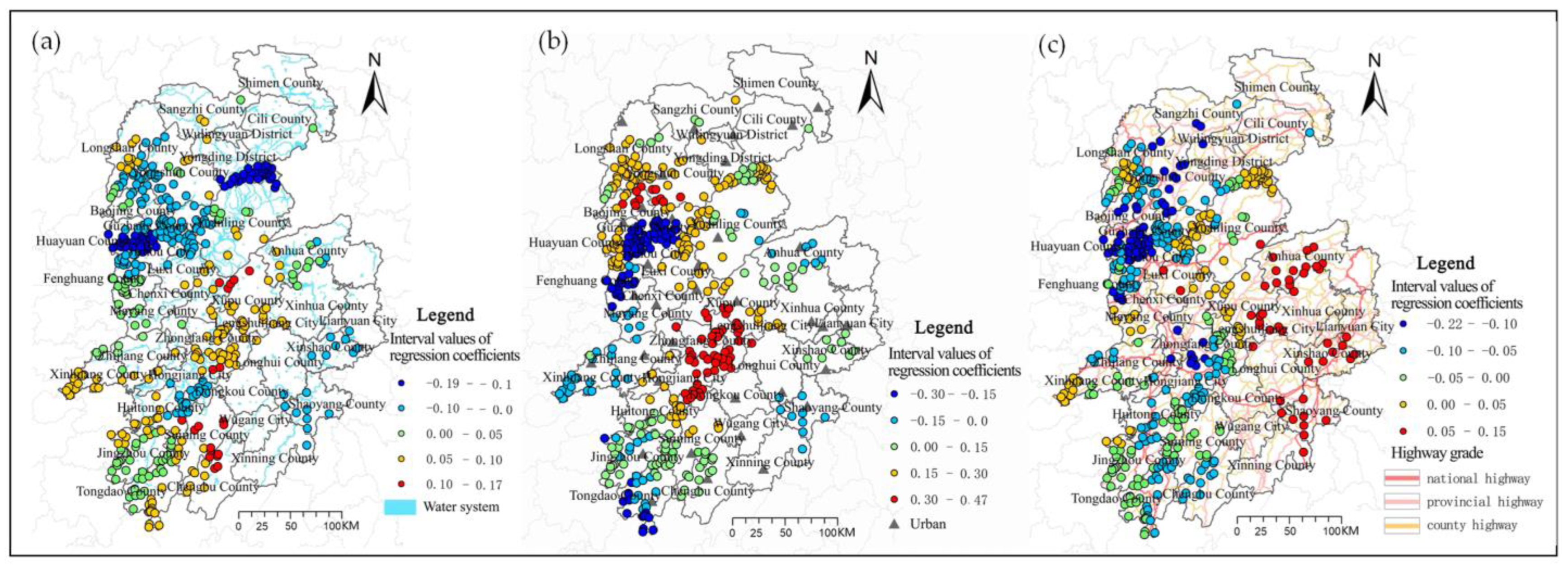
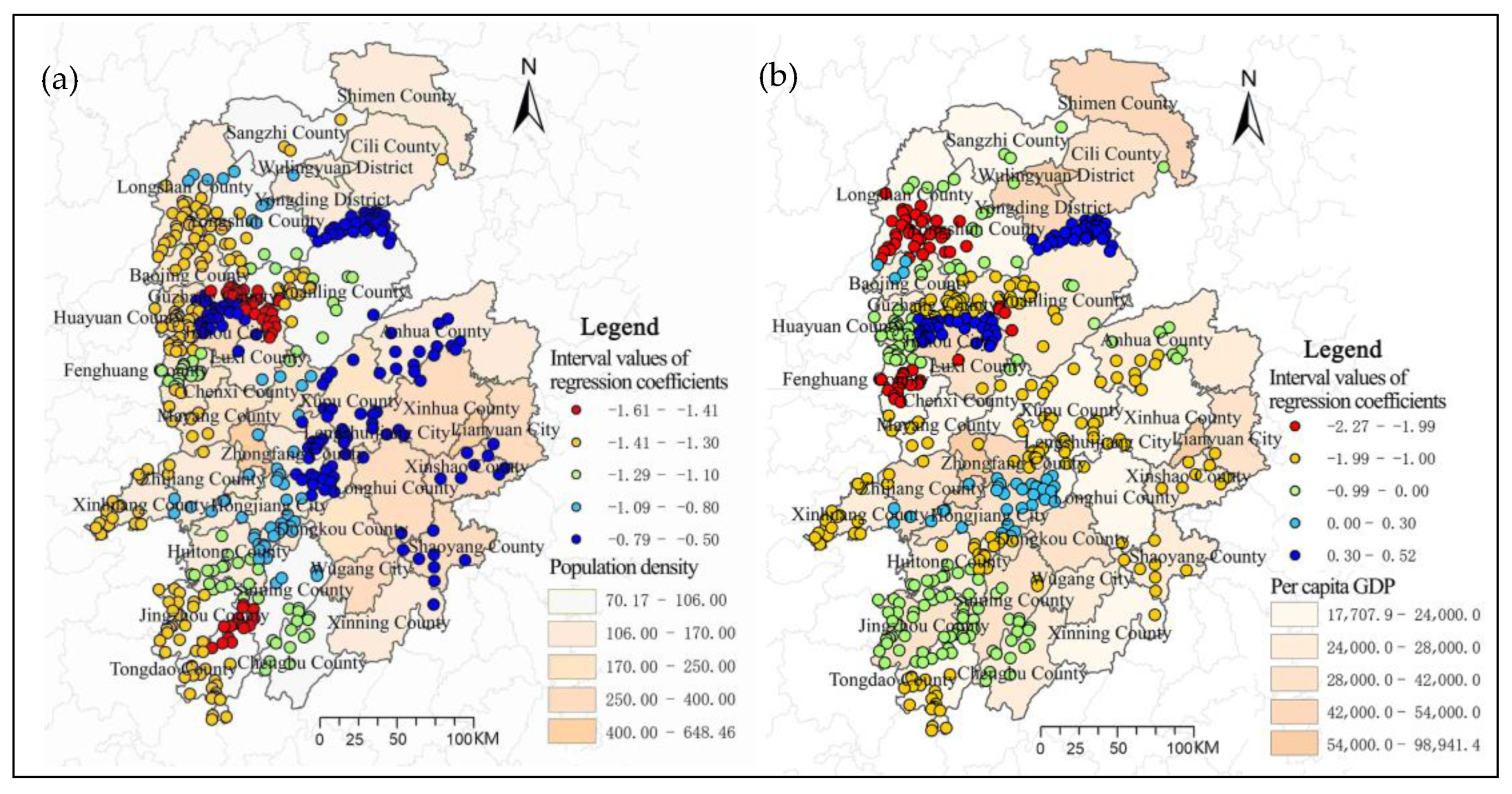
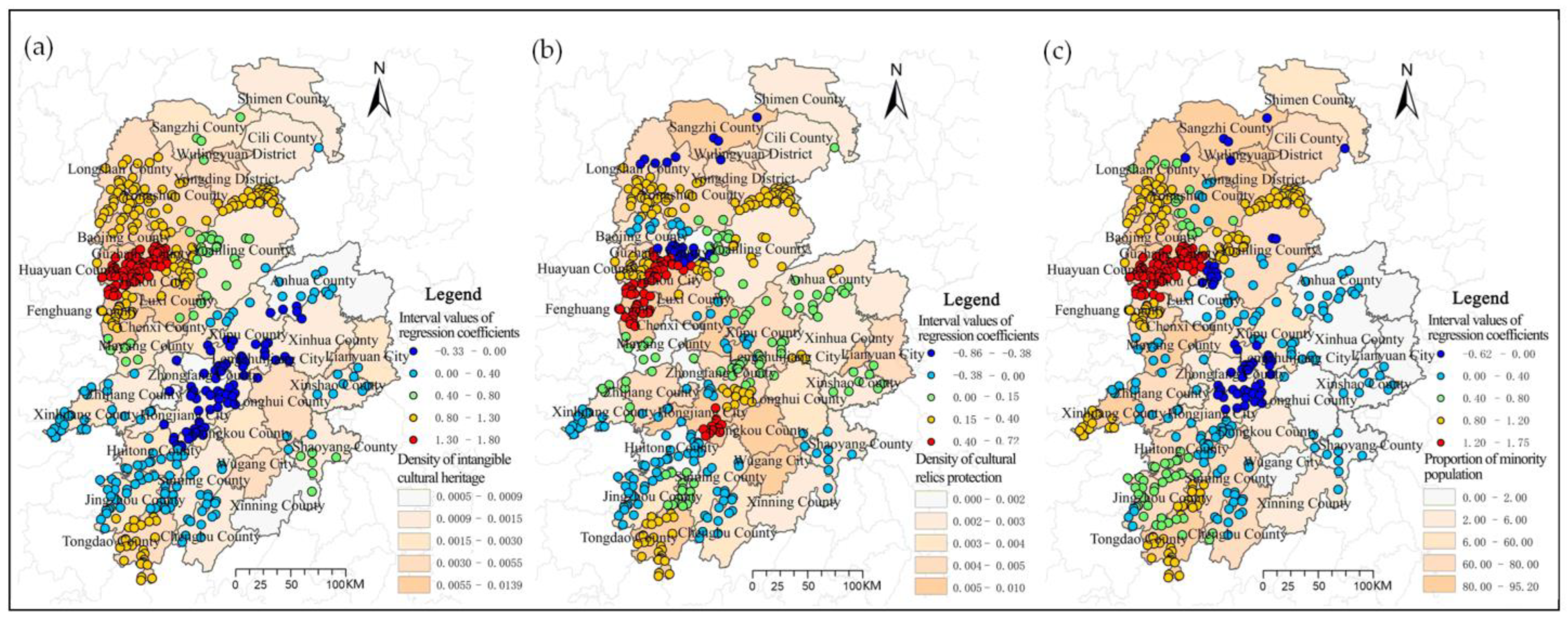
| Type | Index | Calculation Method | Data Sources |
|---|---|---|---|
| Natural factor | Elevation | Elevation values of point features | Geospatial Data Cloud (DEM30m Data) |
| Woodland | The ratio of woodland area to grid area of the grid where the point feature is located | Resource and Environmental Science and Data Center | |
| Arable land | The ratio of arable land area to grid area of the grid where the point feature is located | ||
| Space factor | River system accessibility | The distance from the point feature to the nearest major river system | National Catalogue Service For Geographic Information |
| Transportation accessibility | The distance from the point feature to the nearest major highway. The highway mainly includes national highways, provincial highways, and county highways. | ||
| Urban accessibility | The distance from the point feature to urban above county level | Amap | |
| Socioeconomic factor | Population density | The population density of the county, district and city where the point feature is located | Hunan Bureau of Statistics website |
| Per capita gross domestic product (GDP) | The per capita GDP of the county, district and city where the point element is located | ||
| Cultural factor | Density of intangible cultural heritage | The density of intangible cultural heritage in the county, district and city where the point element is located | China Intangible Cultural Heritage website, and Hunan People’s Government website |
| Density of cultural relics protection units | The density of cultural relics protection units in the county, district and city where the point element is located | Chinese Cultural Heritage Administration website, and Hunan People’s Government website | |
| Proportion of minority population | The proportion of minority population in the county, district and city where the point feature is located | Hunan Bureau of Statistics website |
| Type | p Value | Spatial Distribution Type * | ||||
|---|---|---|---|---|---|---|
| Overall | 5327.80 | 7680.13 | 0.69 | 0 | −12.59 | Clustering |
| Miao | 5411.81 | 8525.64 | 0.63 | 0 | −8.44 | Clustering |
| Tujia | 6234.42 | 8405.61 | 0.74 | 0 | −4.61 | Clustering |
| Dong | 6855.02 | 8348.59 | 0.76 | 0.008 | −2.62 | Clustering |
| Yao | 4694.83 | 6353.29 | 0.75 | 0.025 | −2.23 | Clustering |
| Type | Long Semi-Axis (km) | Short Semi-Axis (km) | Azimuth (°) | Area (km2) |
|---|---|---|---|---|
| Overall | 131.06 | 80.50 | 4.14 | 36,137.26 |
| Miao | 120.41 | 44.46 | 177.61 | 16,818.73 |
| Tujia | 72.43 | 30.19 | 86.71 | 7020.61 |
| Dong | 85.72 | 36.87 | 157.85 | 9929.32 |
| Yao | 47.22 | 12.48 | 28.78 | 1851.72 |
| Diagnostic Indicators | OLS Model | GWR Model | MGWR Model |
|---|---|---|---|
| R2 | 0.617 | 0.646 | 0.903 |
| A-R2 | 0.607 | 0.634 | 0.876 |
| AICc | 3440.69 | 810.757 | 353.066 |
| Type | Index | Bandwidth | Significance | Maximum Value of Regression Coefficient | Minimum Value of Regression Coefficient | Positive Regression Coefficient Percentage | Negative Regression Coefficient Percentage |
|---|---|---|---|---|---|---|---|
| Natural Factor | Elevation | 366 | 24.77% | 0.283 | −0.573 | 48.84% | 51.16% |
| Woodland | 88 | 87.96% | 1.443 | 0.009 | 100.00% | 0.00% | |
| Arable land | 43 | 81.25% | 1.716 | −0.001 | 99.77% | 0.23% | |
| Space factor | River system accessibility | 399 | 16.43% | 0.171 | −0.191 | 54.63% | 45.37% |
| Transportation accessibility | 399 | 10.88% | 0.152 | −0.224 | 34.72% | 65.28% | |
| Urban accessibility | 43 | 56.02% | 0.471 | −0.309 | 75.46% | 24.54% | |
| Socioeconomic factor | Population density | 43 | 100.00% | −0.058 | −1.613 | 0.00% | 100.00% |
| Per capita GDP | 86 | 87.5% | 0.536 | −2.279 | 31.94% | 68.06% | |
| Cultural factor | Density of intangible cultural heritage | 43 | 54.17% | 1.803 | −0.333 | 84.26% | 15.74% |
| Density of cultural relics protection units | 43 | 20.83% | 0.723 | −0.861 | 52.31% | 47.69% | |
| Proportion of minority population | 43 | 68.52% | 1.753 | −0.629 | 84.72% | 15.28% |
Disclaimer/Publisher’s Note: The statements, opinions and data contained in all publications are solely those of the individual author(s) and contributor(s) and not of MDPI and/or the editor(s). MDPI and/or the editor(s) disclaim responsibility for any injury to people or property resulting from any ideas, methods, instructions or products referred to in the content. |
© 2023 by the authors. Licensee MDPI, Basel, Switzerland. This article is an open access article distributed under the terms and conditions of the Creative Commons Attribution (CC BY) license (https://creativecommons.org/licenses/by/4.0/).
Share and Cite
Li, T.; Li, C.; Zhang, R.; Cong, Z.; Mao, Y. Spatial Heterogeneity and Influence Factors of Traditional Villages in the Wuling Mountain Area, Hunan Province, China Based on Multiscale Geographically Weighted Regression. Buildings 2023, 13, 294. https://doi.org/10.3390/buildings13020294
Li T, Li C, Zhang R, Cong Z, Mao Y. Spatial Heterogeneity and Influence Factors of Traditional Villages in the Wuling Mountain Area, Hunan Province, China Based on Multiscale Geographically Weighted Regression. Buildings. 2023; 13(2):294. https://doi.org/10.3390/buildings13020294
Chicago/Turabian StyleLi, Ting, Chaokui Li, Rui Zhang, Zheng Cong, and Yan Mao. 2023. "Spatial Heterogeneity and Influence Factors of Traditional Villages in the Wuling Mountain Area, Hunan Province, China Based on Multiscale Geographically Weighted Regression" Buildings 13, no. 2: 294. https://doi.org/10.3390/buildings13020294





